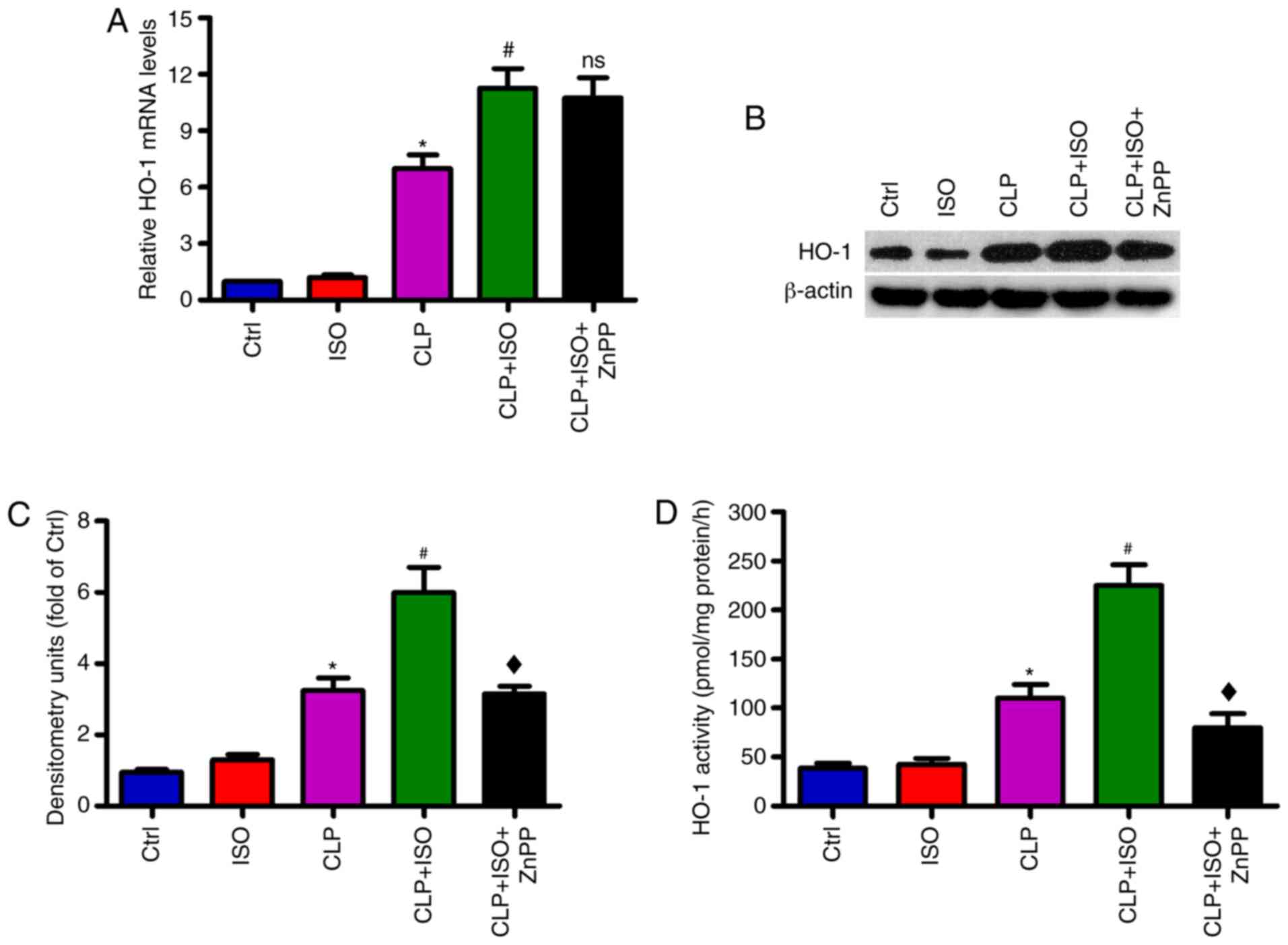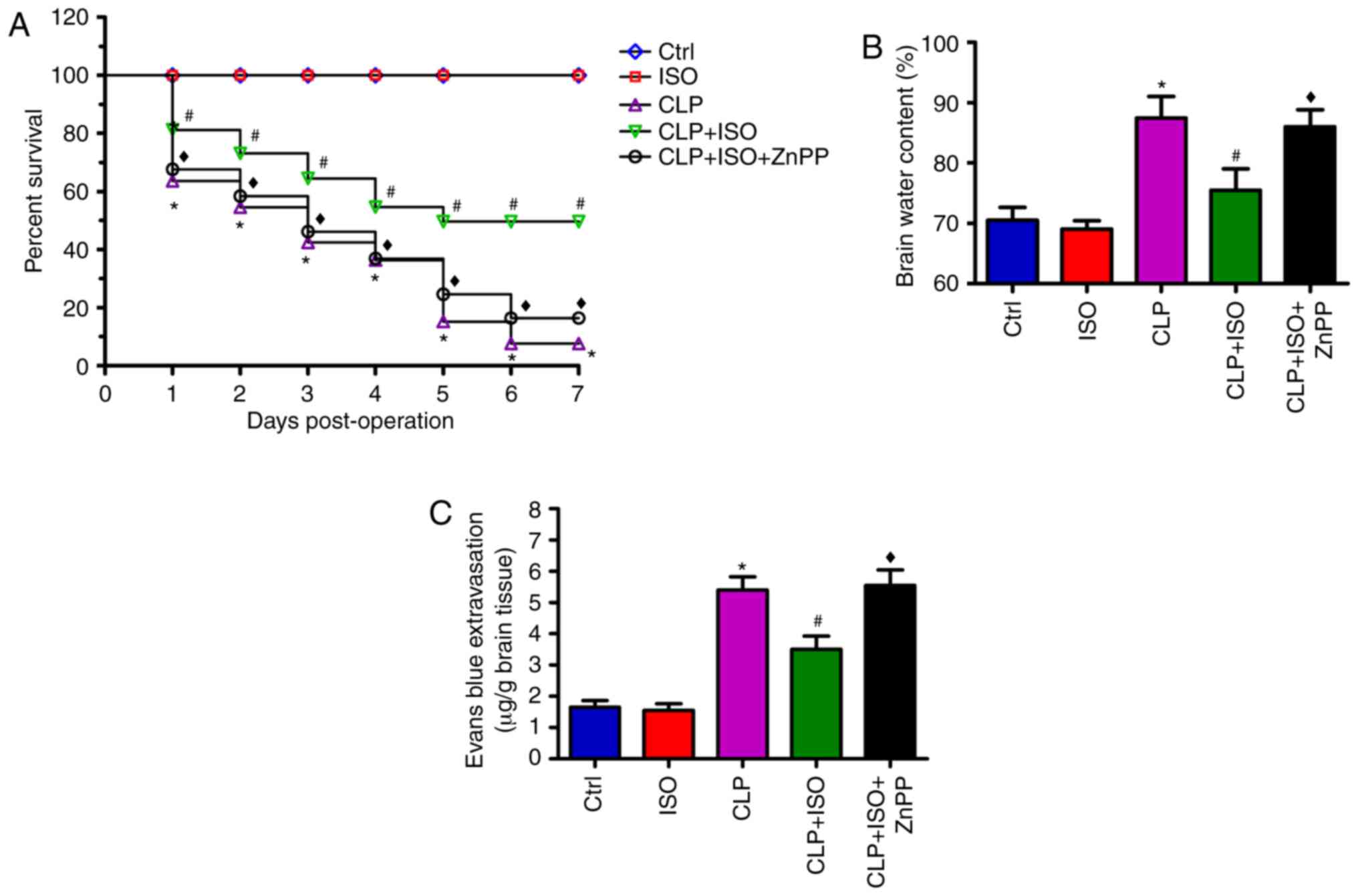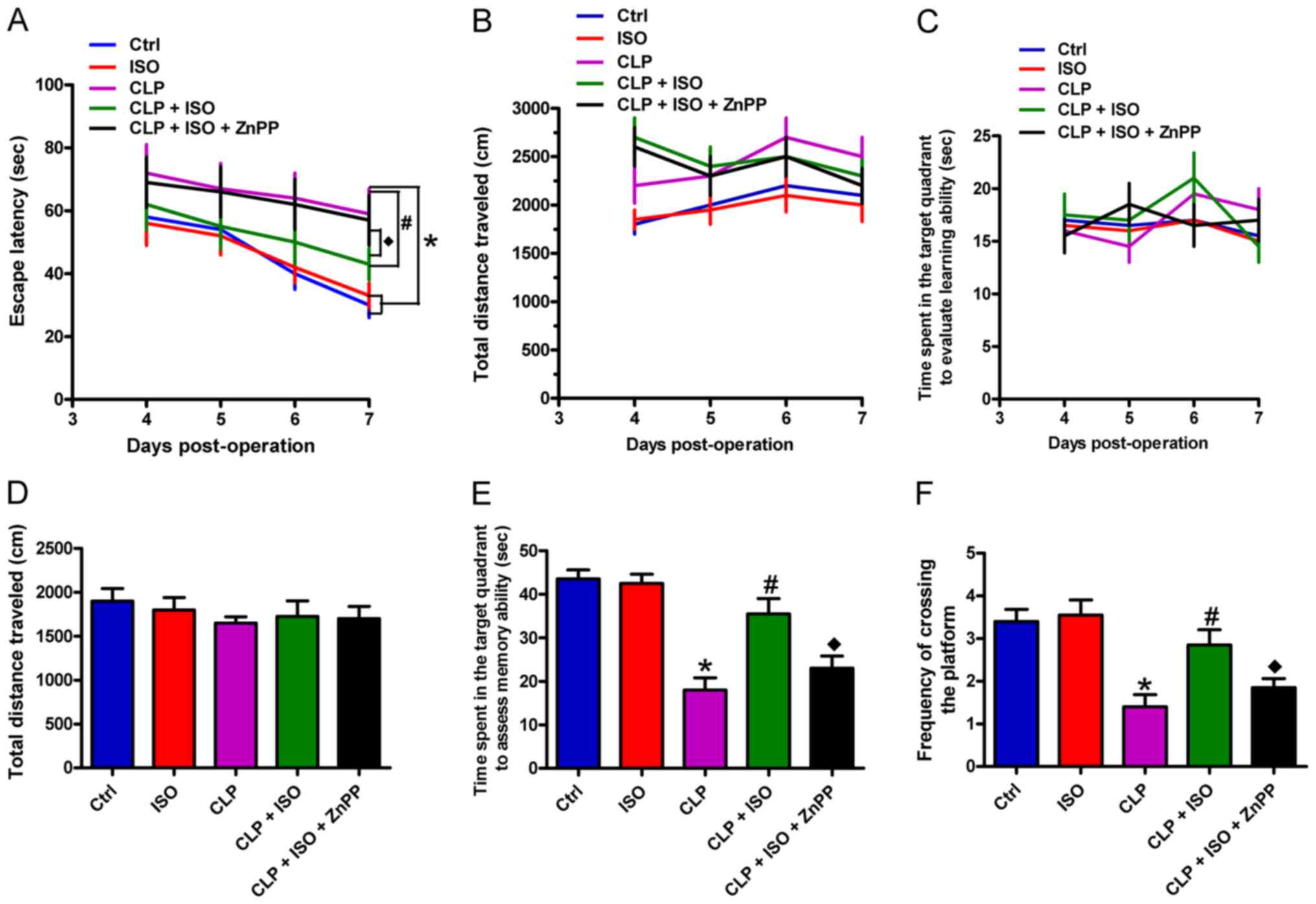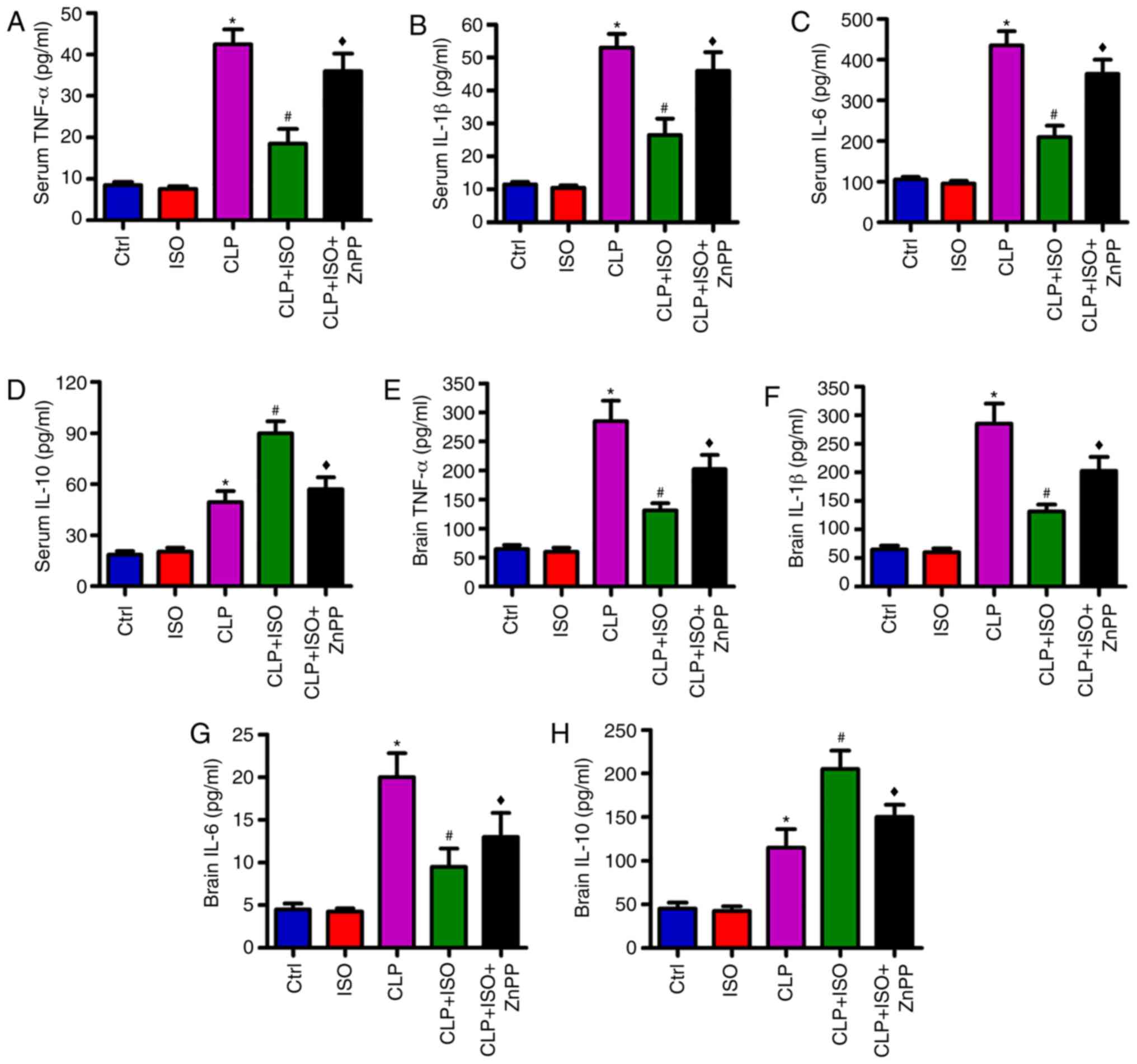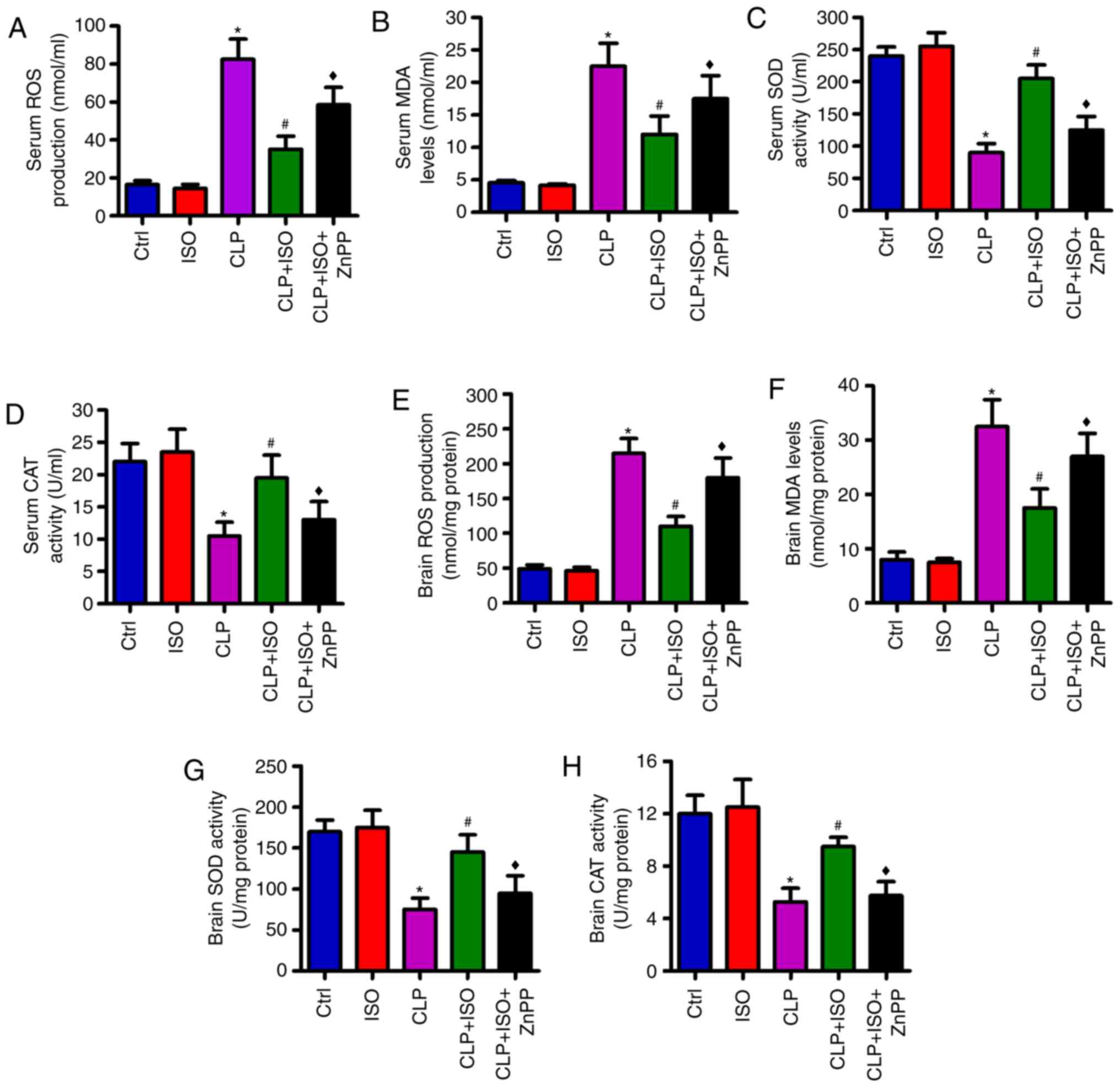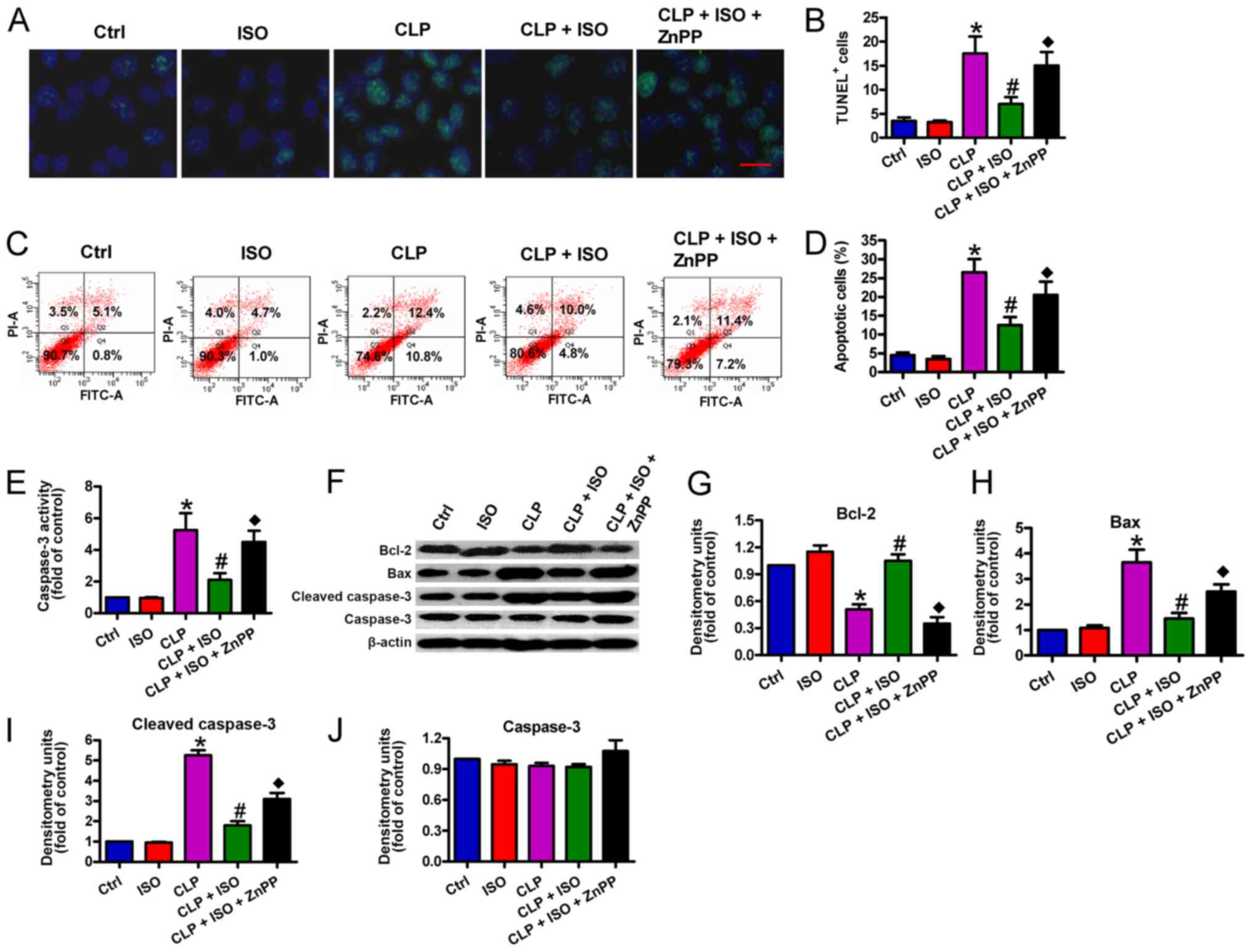|
1
|
Delano MJ and Ward PA: Sepsis-induced
immune dysfunction: Can immune therapies reduce mortality? J Clin
Invest. 126:23–31. 2016. View
Article : Google Scholar : PubMed/NCBI
|
|
2
|
Dellinger RP, Levy MM, Rhodes A, Annane D,
Gerlach H, Opal SM, Sevransky JE, Sprung CL, Douglas IS, Jaeschke
R, et al: Surviving sepsis campaign: International guidelines for
management of severe sepsis and septic shock: 2012. Crit Care Med.
41:580–637. 2013. View Article : Google Scholar : PubMed/NCBI
|
|
3
|
Gong Y, Lan H, Yu Z, Wang M, Wang S, Chen
Y, Rao H, Li J, Sheng Z and Shao J: Blockage of glycolysis by
targeting PFKFB3 alleviates sepsis-related acute lung injury via
suppressing inflammation and apoptosis of alveolar epithelial
cells. Biochem Biophys Res Commun. 491:522–529. 2017. View Article : Google Scholar : PubMed/NCBI
|
|
4
|
Alobaidi R, Basu RK, Goldstein SL and
Bagshaw SM: Sepsis-associated acute kidney injury. Semin Nephrol.
35:2–11. 2015. View Article : Google Scholar : PubMed/NCBI
|
|
5
|
Martin L, Derwall M, Al Zoubi S,
Zechendorf E, A Reuter D, Thiemermann C and Schuerholz T: The
septic heart: Current understanding of molecular mechanisms and
clinical implications. Chest. 155:427–437. 2019. View Article : Google Scholar : PubMed/NCBI
|
|
6
|
Yan J and Li S and Li S: The role of the
liver in sepsis. Int Rev Immunol. 33:498–510. 2014. View Article : Google Scholar : PubMed/NCBI
|
|
7
|
Zhu Y, Wang K, Ma Z, Liu D, Yang Y, Sun M,
Wen A, Hao Y, Ma S, Ren F, et al: SIRT1 activation by butein
attenuates sepsis-induced brain injury in mice subjected to cecal
ligation and puncture via alleviating inflammatory and oxidative
stress. Toxicol Appl Pharmacol. 363:34–46. 2019. View Article : Google Scholar : PubMed/NCBI
|
|
8
|
Gofton TE and Young GB: Sepsis-associated
encephalopathy. Nat Rev Neurol. 8:557–566. 2012. View Article : Google Scholar : PubMed/NCBI
|
|
9
|
Zhang LN, Wang XT, Ai YH, Guo QL, Huang L,
Liu ZY and Yao B: Epidemiological features and risk factors of
sepsis-associated encephalopathy in intensive care unit patients:
2008–2011. Chin Med J (Engl). 125:828–831. 2012.PubMed/NCBI
|
|
10
|
Iwashyna TJ, Ely EW, Smith DM and Langa
KM: Long-term cognitive impairment and functional disability among
survivors of severe sepsis. JAMA. 304:1787–1794. 2010. View Article : Google Scholar : PubMed/NCBI
|
|
11
|
Barichello T, Martins MR, Reinke A, Feier
G, Ritter C, Quevedo J and Dal-Pizzol F: Cognitive impairment in
sepsis survivors from cecal ligation and perforation. Crit Care
Med. 33:221–223, 262-223. 2005. View Article : Google Scholar : PubMed/NCBI
|
|
12
|
Semmler A, Frisch C, Debeir T, Ramanathan
M, Okulla T, Klockgether T and Heneka MT: Long-term cognitive
impairment, neuronal loss and reduced cortical cholinergic
innervation after recovery from sepsis in a rodent model. Exp
Neurol. 204:733–740. 2007. View Article : Google Scholar : PubMed/NCBI
|
|
13
|
Schwalm MT, Pasquali M, Miguel SP, JPAD
Santos, Vuolo F, Comim CM, Petronilho F, Quevedo J, Gelain DP,
Moreira JCF, et al: Acute brain inflammation and oxidative damage
are related to long-term cognitive deficits and markers of
neurodegeneration in sepsis-survivor rats. Mol Neurobiol.
49:380–385. 2014. View Article : Google Scholar : PubMed/NCBI
|
|
14
|
Comim CM, Barichello T, Grandgirard D,
Dal-Pizzol F, Quevedo J and Leib SL: Caspase-3 mediates in part
hippocampal apoptosis in sepsis. Mol Neurobiol. 47:394–398. 2013.
View Article : Google Scholar : PubMed/NCBI
|
|
15
|
Heine H, Rietschel ET and Ulmer AJ: The
biology of endotoxin. Mol Biotechnol. 19:279–296. 2001. View Article : Google Scholar : PubMed/NCBI
|
|
16
|
Vaure C and Liu Y: A comparative review of
toll-like receptor 4 expression and functionality in different
animal species. Front Immunol. 5:3162014. View Article : Google Scholar : PubMed/NCBI
|
|
17
|
Shukla P, Rao GM, Pandey G, Sharma S,
Mittapelly N, Shegokar R and Mishra PR: Therapeutic interventions
in sepsis: Current and anticipated pharmacological agents. Br J
Pharmacol. 171:5011–5031. 2014.PubMed/NCBI
|
|
18
|
Sonneville R, Verdonk F, Rauturier C,
Klein IF, Wolff M, Annane D, Chretien F and Sharshar T:
Understanding brain dysfunction in sepsis. Ann Intensive Care.
3:152013. View Article : Google Scholar : PubMed/NCBI
|
|
19
|
Danielski LG, Giustina AD, Badawy M,
Barichello T, Quevedo J, Dal-Pizzol F and Petronilho F: Brain
barrier breakdown as a cause and consequence of neuroinflammation
in sepsis. Mol Neurobiol. 55:1045–1053. 2018. View Article : Google Scholar : PubMed/NCBI
|
|
20
|
Abramowitz J and Birnbaumer L: Physiology
and pathophysiology of canonical transient receptor potential
channels. FASEB J. 23:297–328. 2009. View Article : Google Scholar : PubMed/NCBI
|
|
21
|
Fleming I, Fisslthaler B and Busse R:
Calcium signaling in endothelial cells involves activation of
tyrosine kinases and leads to activation of mitogen-activated
protein kinases. Circ Res. 76:522–529. 1995. View Article : Google Scholar : PubMed/NCBI
|
|
22
|
Barichello T, Fortunato JJ, Vitali AM,
Feier G, Reinke A, Moreira JCF, Quevedo J and Dal-Pizzol F:
Oxidative variables in the rat brain after sepsis induced by cecal
ligation and perforation. Crit Care Med. 34:886–889. 2006.
View Article : Google Scholar : PubMed/NCBI
|
|
23
|
Dal-Pizzol F, Ritter C, Cassol OJ Jr,
Rezin GT, Petronilho F, Zugno AI, Quevedo J and Streck EL:
Oxidative mechanisms of brain dysfunction during sepsis. Neurochem
Res. 35:1–12. 2010. View Article : Google Scholar : PubMed/NCBI
|
|
24
|
Hoetzel A and Schmidt R: Regulatory role
of anesthetics on heme oxygenase-1. Curr Drug Targets.
11:1495–1503. 2010. View Article : Google Scholar : PubMed/NCBI
|
|
25
|
Alcaraz MJ, Fernandez P and Guillen MI:
Anti-inflammatory actions of the heme oxygenase-1 pathway. Curr
Pharm Des. 9:2541–2551. 2003. View Article : Google Scholar : PubMed/NCBI
|
|
26
|
Chen K, Gunter K and Maines MD: Neurons
overexpressing heme oxygenase-1 resist oxidative stress-mediated
cell death. J Neurochem. 75:304–313. 2000. View Article : Google Scholar : PubMed/NCBI
|
|
27
|
Dong X, Hu R, Sun Y, Li Q and Jiang H:
Isoflurane post-treatment improves pulmonary vascular permeability
via upregulation of heme oxygenase-1. Exp Lung Res. 39:295–303.
2013. View Article : Google Scholar : PubMed/NCBI
|
|
28
|
Yu JB, Zhou F, Yao SL, Tang ZH, Wang M and
Chen HR: Effect of heme oxygenase-1 on the kidney during septic
shock in rats. Transl Res. 153:283–287. 2009. View Article : Google Scholar : PubMed/NCBI
|
|
29
|
Park JS, Choi HS, Yim SY and Lee SM: Heme
oxygenase-1 protects the liver from septic injury by modulating
TLR4-mediated mitochondrial quality control in mice. Shock.
50:209–218. 2018. View Article : Google Scholar : PubMed/NCBI
|
|
30
|
Liu L, Xie K, Chen H, Dong X, Li Y and Yu
Y, Wang G and Yu Y: Inhalation of hydrogen gas attenuates brain
injury in mice with cecal ligation and puncture via inhibiting
neuroinflammation, oxidative stress and neuronal apoptosis. Brain
Res. 1589:78–92. 2014. View Article : Google Scholar : PubMed/NCBI
|
|
31
|
Flondor M, Hofstetter C, Boost KA, Betz C,
Homann M and Zwissler B: Isoflurane inhalation after induction of
endotoxemia in rats attenuates the systemic cytokine response. Eur
Surg Res. 40:1–6. 2008. View Article : Google Scholar : PubMed/NCBI
|
|
32
|
Jamnicki-Abegg M, Weihrauch D, Pagel PS,
Kersten JR, Bosnjak ZJ, Warltier DC and Bienengraeber MW:
Isoflurane inhibits cardiac myocyte apoptosis during oxidative and
inflammatory stress by activating Akt and enhancing Bcl-2
expression. Anesthesiology. 103:1006–1014. 2005. View Article : Google Scholar : PubMed/NCBI
|
|
33
|
Head BP and Patel P: Anesthetics and brain
protection. Curr Opin Anaesthesiol. 20:395–399. 2007. View Article : Google Scholar : PubMed/NCBI
|
|
34
|
Sakai H, Sheng H, Yates RB, Ishida K,
Pearlstein RD and Warner DS: Isoflurane provides long-term
protection against focal cerebral ischemia in the rat.
Anesthesiology. 106:92–99; discussion 98–10. 2007. View Article : Google Scholar : PubMed/NCBI
|
|
35
|
Li QF, Zhu YS, Jiang H, Xu H and Sun Y:
Heme oxygenase-1 mediates the anti-inflammatory effect of
isoflurane preconditioning in LPS-stimulated macrophages. Acta
Pharmacol Sin. 30:228–234. 2009. View Article : Google Scholar : PubMed/NCBI
|
|
36
|
Li Q, Zhu Y, Jiang H, Xu H and Liu H:
Up-regulation of heme oxygenase-1 by isoflurane preconditioning
during tolerance against neuronal injury induced by oxygen glucose
deprivation. Acta Biochim Biophys Sin (Shanghai). 40:803–810. 2008.
View Article : Google Scholar : PubMed/NCBI
|
|
37
|
Sackey PV, Martling CR, Carlswärd C,
Sundin O and Radell PJ: Short- and long-term follow-up of intensive
care unit patients after sedation with isoflurane and midazolam-a
pilot study. Crit Care Med. 36:801–806. 2008. View Article : Google Scholar : PubMed/NCBI
|
|
38
|
Li JT, Wang H, Li W, Wang LF, Hou LC, Mu
JL, Liu X, Chen HJ, Xie KL, Li NL and Gao CF: Anesthetic isoflurane
posttreatment attenuates experimental lung injury by inhibiting
inflammation and apoptosis. Mediators Inflamm. 2013:1089282013.
View Article : Google Scholar : PubMed/NCBI
|
|
39
|
Wang H, Fan J, Li NL, Li JT, Yuan SF, Yi
J, Wang L, Chen JH, Lv YG, Yao Q, et al: A subanesthetic dose of
isoflurane during postconditioning ameliorates zymosan-induced
neutrophil inflammation lung injury and mortality in mice.
Mediators Inflamm. 2013:4796282013. View Article : Google Scholar : PubMed/NCBI
|
|
40
|
Wang H, Wang L, Li NL, Li JT, Yu F, Zhao
YL, Wang L, Yi J, Wang L, Bian JF, et al: Subanesthetic isoflurane
reduces zymosan-induced inflammation in murine Kupffer cells by
inhibiting ROS-activated p38 MAPK/NF-κB signaling. Oxid Med Cell
Longev. 2014:8516922014. View Article : Google Scholar : PubMed/NCBI
|
|
41
|
Kilkenny C, Browne W, Cuthill IC, Emerson
M and Altman DG; National Centre for the Replacement, Refinement
and Reduction of Amimals in Research, : Animal research: Reporting
in vivo experiments-the ARRIVE guidelines. J Cereb Blood Flow
Metab. 31:991–993. 2011. View Article : Google Scholar : PubMed/NCBI
|
|
42
|
Toscano MG, Ganea D and Gamero AM: Cecal
ligation puncture procedure. J Vis Exp. 7:28602011.
|
|
43
|
Mu J, Xie K, Hou L, Peng D, Shang L, Ji G,
Li J, Lu Y and Xiong L: Subanesthetic dose of isoflurane protects
against zymosan-induced generalized inflammation and its associated
acute lung injury in mice. Shock. 34:183–189. 2010. View Article : Google Scholar : PubMed/NCBI
|
|
44
|
Sui DM, Xie Q, Yi WJ, Gupta S, Yu XY, Li
JB, Wang J, Wang JF and Deng XM: Resveratrol protects against
sepsis-associated encephalopathy and inhibits the NLRP3/IL-1β axis
in microglia. Mediators Inflamm. 2016:10456572016. View Article : Google Scholar : PubMed/NCBI
|
|
45
|
Hatashita S, Hoff JT and Salamat SM:
Ischemic brain edema and the osmotic gradient between blood and
brain. J Cereb Blood Flow Metab. 8:552–559. 1988. View Article : Google Scholar : PubMed/NCBI
|
|
46
|
Livak KJ and Schmittgen TD: Analysis of
relative gene expression data using real-time quantitative PCR and
the 2(-Delta Delta C(T)) method. Methods. 25:402–408. 2001.
View Article : Google Scholar : PubMed/NCBI
|
|
47
|
Jiang M, Sun L, Feng DX, Yu ZQ, Gao R, Sun
YZ and Chen G: Neuroprotection provided by isoflurane
pre-conditioning and post-conditioning. Med Gas Res. 7:48–55. 2017.
View Article : Google Scholar : PubMed/NCBI
|
|
48
|
Wang S, Yin J, Ge M, Dai Z, Li Y, Si J, Ma
K, Li L and Yao S: Transforming growth-beta 1 contributes to
isoflurane postconditioning against cerebral ischemia-reperfusion
injury by regulating the c-Jun N-terminal kinase signaling pathway.
Biomed Pharmacother. 78:280–290. 2016. View Article : Google Scholar : PubMed/NCBI
|
|
49
|
Xu Y, Xue H, Zhao P, Yang Y, Ji G, Yu W,
Han G, Ding M and Wang F: Isoflurane postconditioning induces
concentration- and timing-dependent neuroprotection partly mediated
by the GluR2 AMPA receptor in neonatal rats after brain
hypoxia-ischemia. J Anesth. 30:427–436. 2016. View Article : Google Scholar : PubMed/NCBI
|
|
50
|
Zhao DA, Bi LY, Huang Q, Zhang FM and Han
ZM: Isoflurane provides neuroprotection in neonatal hypoxic
ischemic brain injury by suppressing apoptosis. Braz J Anesthesiol.
66:613–621. 2016. View Article : Google Scholar : PubMed/NCBI
|
|
51
|
Matsuda A, Jacob A, Wu R, Aziz M, Yang WL,
Matsutani T, Suzuki H, Furukawa K, Uchida E and Wang P: Novel
therapeutic targets for sepsis: Regulation of exaggerated
inflammatory responses. J Nippon Med Sch. 79:4–18. 2012. View Article : Google Scholar : PubMed/NCBI
|
|
52
|
Calabresi P, Castrioto A, Di Filippo M and
Picconi B: New experimental and clinical links between the
hippocampus and the dopaminergic system in Parkinson's disease.
Lancet Neurol. 12:811–821. 2013. View Article : Google Scholar : PubMed/NCBI
|
|
53
|
Alexander JJ, Jacob A, Cunningham P,
Hensley L and Quigg RJ: TNF is a key mediator of septic
encephalopathy acting through its receptor, TNF receptor-1.
Neurochem Int. 52:447–456. 2008. View Article : Google Scholar : PubMed/NCBI
|
|
54
|
Rothwell NJ and Hopkins SJ: Cytokines and
the nervous system II: Actions and mechanisms of action. Trends
Neurosci. 18:130–136. 1995. View Article : Google Scholar : PubMed/NCBI
|
|
55
|
Sharief MK and Thompson EJ: In vivo
relationship of tumor necrosis factor-alpha to blood-brain barrier
damage in patients with active multiple sclerosis. J Neuroimmunol.
38:27–33. 1992. View Article : Google Scholar : PubMed/NCBI
|
|
56
|
Williams LM, Ricchetti G, Sarma U, Smallie
T and Foxwell BM: Interleukin-10 suppression of myeloid cell
activation-a continuing puzzle. Immunology. 113:281–292. 2004.
View Article : Google Scholar : PubMed/NCBI
|
|
57
|
Altay O, Suzuki H, Hasegawa Y, Ostrowski
RP, Tang J and Zhang JH: Isoflurane on brain inflammation.
Neurobiol Dis. 62:365–371. 2014. View Article : Google Scholar : PubMed/NCBI
|
|
58
|
Li QF, Wang XR, Yang YW and Su DS:
Up-regulation of hypoxia inducible factor 1alpha by isoflurane in
Hep3B cells. Anesthesiology. 105:1211–1219. 2006. View Article : Google Scholar : PubMed/NCBI
|
|
59
|
Schmidt R, Tritschler E, Hoetzel A, Loop
T, Humar M, Halverscheid L, Geiger KK and Pannen BH: Heme
oxygenase-1 induction by the clinically used anesthetic isoflurane
protects rat livers from ischemia/reperfusion injury. Ann Surg.
245:931–942. 2007. View Article : Google Scholar : PubMed/NCBI
|
|
60
|
Hopkins RO: Sepsis, oxidative stress, and
brain injury. Crit Care Med. 35:2233–2234. 2007. View Article : Google Scholar : PubMed/NCBI
|
|
61
|
Chandra J, Samali A and Orrenius S:
Triggering and modulation of apoptosis by oxidative stress. Free
Radic Biol Med. 29:323–333. 2000. View Article : Google Scholar : PubMed/NCBI
|
|
62
|
Requena JR, Fu MX, Ahmed MU, Jenkins AJ,
Lyons TJ and Thorpe SR: Lipoxidation products as biomarkers of
oxidative damage to proteins during lipid peroxidation reactions.
Nephrol Dial Transplant. 11 (Suppl 5):48–53. 1996. View Article : Google Scholar : PubMed/NCBI
|
|
63
|
Yang T, Sun Y and Zhang F: Anti-oxidative
aspect of inhaled anesthetic gases against acute brain injury. Med
Gas Res. 6:223–226. 2016. View Article : Google Scholar : PubMed/NCBI
|
|
64
|
Yu J, Wang Y, Li Z, Dong S, Wang D, Gong
L, Shi J, Zhang Y, Liu D and Mu R: Effect of heme oxygenase-1 on
mitofusin-1 protein in LPS-induced ALI/ARDS in rats. Sci Rep.
6:365302016. View Article : Google Scholar : PubMed/NCBI
|
|
65
|
Semmler A, Okulla T, Sastre M,
Dumitrescu-Ozimek L and Heneka MT: Systemic inflammation induces
apoptosis with variable vulnerability of different brain regions. J
Chem Neuroanat. 30:144–157. 2005. View Article : Google Scholar : PubMed/NCBI
|
|
66
|
Yao XL, Liu J, Lee E, Ling GS and McCabe
JT: Progesterone differentially regulates pro- and anti-apoptotic
gene expression in cerebral cortex following traumatic brain injury
in rats. J Neurotrauma. 22:656–668. 2005. View Article : Google Scholar : PubMed/NCBI
|
|
67
|
Renault TT, Teijido O, Antonsson B, Dejean
LM and Manon S: Regulation of Bax mitochondrial localization by
Bcl-2 and Bcl-x(L): Keep your friends close but your enemies
closer. Int J Biochem Cell Biol. 45:64–67. 2013. View Article : Google Scholar : PubMed/NCBI
|
|
68
|
Li L, Peng L and Zuo Z: Isoflurane
preconditioning increases B-cell lymphoma-2 expression and reduces
cytochrome c release from the mitochondria in the ischemic penumbra
of rat brain. Eur J Pharmacol. 586:106–113. 2008. View Article : Google Scholar : PubMed/NCBI
|
|
69
|
Bedirli N, Bagriacik EU, Emmez H, Yilmaz
G, Unal Y and Ozkose Z: Sevoflurane and isoflurane preconditioning
provides neuroprotection by inhibition of apoptosis-related mRNA
expression in a rat model of focal cerebral ischemia. J Neurosurg
Anesthesiol. 24:336–344. 2012. View Article : Google Scholar : PubMed/NCBI
|
|
70
|
Wang L, Zhao YL, Liu NN, Zhu XS, Liu QQ,
Mei HY, Wang LF, Yang AG, Gao CF and Li JT: Epithelial HO-1/STAT3
affords the protection of subanesthetic isoflurane against
zymosan-induced lung injury in mice. Oncotarget. 8:54889–54903.
2017. View Article : Google Scholar : PubMed/NCBI
|















